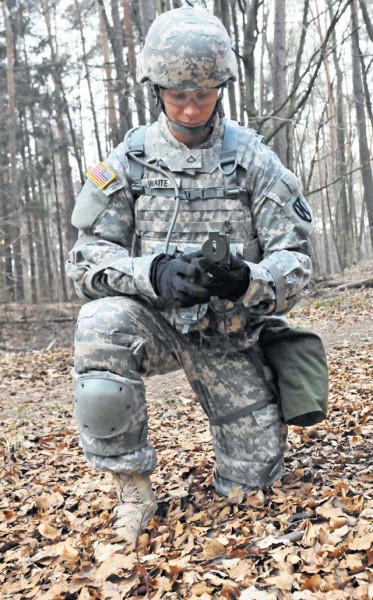
21st Theater Sustainment Command, checks his azimuth during the daytime land navigation portion of the 21st TSC’s 21st Special Troops Battalion Best Warrior Competition April 3 on Rhine Ordnance Barracks.
Twelve Soldiers, NCOs and officers competed in this year’s 21st Special Troops Battalion, 21st Theater Sustainment Command Best Warrior competition March 28 through April 4.
The competitors came from throughout the 21st STB including Headquarters and Headquarters Company, 266th Financial Management Support Center and 5th Quartermaster Detachment. The warriors came from a variety of Soldiering backgrounds from brand new privates to warriors with multiple deployments, and each of them came to win.
“This is a great competition and I am happy to be a part of it,” said Pfc. Shane T. Waite, an intelligence analyst assigned to the 21st TSC. “I think everyone is giving their all in this competition… it’s definitely tough.”
The competition began in Landstuhl with a qualification range. Each warrior zeroed and qualified to the best of their ability with their assigned weapon which included the M16 rifle and M9 pistol.
On April 1, the competition resumed at 4:30 a.m. on Rhine Ordnance Barracks for pre-combat inspections and an alternate event Army physical fitness test. The Soldiers conducted the push-up and sit-up events in the Army Combat Uniform and running shoes. They also conducted the two-mile run event in the same uniform while carrying an M16, said Master Sgt. Kory L. Ysen, the 21st STB operations sergeant.
The competitors immediately went from the APFT into a 12-mile timed ruck-march with a 50-pound pack.
“The ruck-march was definitely the hardest part of the competition,” said Pvt. Kyle M. Stephens, a parachute rigger assigned to the 5th QM Det., 21st STB. “We were already tired from doing the PT-test so rucking 12 miles on top of that really took it out of us.”
The day ended with a first aid evaluation followed by a stress-shooting and reflexive-fire range. The stress-shoot and reflexive-fire range was conducted on Panzer Kaserne at the Engagement Skills Trainer 2000.
“Before they got to fire, we made the competitors do various exercises to tire them out,” Ysen said. “The goal for the cadre is to make sure each of these warriors goes home completely exhausted every day. Then, they come back the next day and we wear them out all over again.”
The following day began at 6:30 a.m. with individual evaluations on the competitor’s ability to instruct physical readiness training. Each warrior was heavily scrutinized on each exercise. One false move, wrong command or improper cadence would cost points.
The competition moved into a classroom for individual weapons and grenade familiarity and then back outdoors for a media engagement lane.
“The Soldiers were graded on their ability to interact with civilian news media. They were asked questions based on a fictional sexual harassment incident that occurred on the base,” said Sgt. 1st Class Ian M. Camejo Jr., the 21st TSC public affairs operations NCO. “The Soldiers were evaluated based on how well they answered the questions accurately while not providing information that wasn’t releasable to the media at that time.”
Following the media engagement lane, the warriors went into squad tactical exercises including: move under direct and indirect fire and four-man litter carries for 600 meters.
Due to scheduling constraints, the next day of competition began in the afternoon with Modern Army Combatives. Each competitor was paired against someone of equal weight and conducted a combatives spar for up to six minutes or submission. Warriors received points for gaining control, mounts, bars and submissions.
“Make no mistake, it doesn’t seem like a long time but six minutes of combatives is exhausting,” Ysen said.
The competition then moved to the land-navigation course on Rhine Ordnance Barracks for both day-time and night-time land navigation. This portion of the competition took each warrior into the early morning hours of April 4.
At 6:30 a.m. April 4, each competitor submitted an essay about one of three topics: suicide prevention, training management and how to keep Soldiers in the Army. An hour later, each warrior appeared before a board of five sergeants major to be evaluated on appearance, military bearing, military knowledge and to discuss their essay.
Only hours later, before a battalion formation, the winners of the competition were announced. The Best Warrior, enlisted category and overall competition winner was Spc. Casey J. Mayfield, an information systems specialist assigned to the 21st TSC communication section. The Best Warrior, NCO category winner was Sgt. Matthew J. Langton, a parachute rigger inspector and tester assigned to the 5th QM Det. The Best Warrior, officer category winner was 1st Lt. Philip M. Messina, the executive officer of the 5th QM Det.
“It feels great to be the winner, I put everything I had into it and it paid off,” Mayfield said. “For people who want to participate in this kind of event in the future, don’t focus so hard on the physical portion but get your mind and Soldier skills prepared.”


